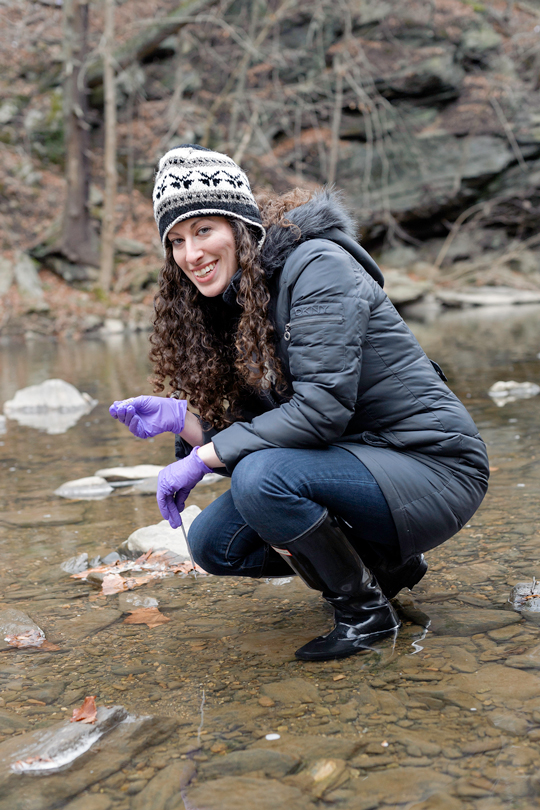 Rachel Rosenfeld, a citizen scientist, measures phosphate levels for Wissahickon Valley Watershed Association’s Creek Watch program near Valley Green Inn in Fairmount Park. | Photo by Christian Hunold
Rachel Rosenfeld, a citizen scientist, measures phosphate levels for Wissahickon Valley Watershed Association’s Creek Watch program near Valley Green Inn in Fairmount Park. | Photo by Christian Hunold
Volunteers wade in to monitor the Wissahickon
Rachel Rosenfeld crunched her way through the ice near the shore to get to where she could drop her thermometer into the Wissahickon Creek, just upstream from the Valley Green Inn. Fishing it out of the near-freezing water would hurt, but you need measurements throughout the year to draw a complete picture of the Creek. Rosenfeld, along with other volunteers checking 35 sections of the Wissahickon and its tributaries, visits monthly to check on its health, even in the cold months.
You cannot step into the same river or creek twice, which makes it hard to monitor water quality. The flow at any given moment is a mix of rainwater, groundwater and whatever chemicals have been washed in from the land or generated by life in the river. Any water sample you take is a snapshot, but the more snapshots you get, the better you can understand the state of the creek.
Up until August of 2014, the Wissahickon was checked four times per year at just four locations. The Creek Watch, a program of the Wissahickon Valley Watershed Association, now has more than 70 volunteers visiting 35 sections of the creek monthly.
“We were completely thrilled and taken by surprise by how big the response was,” says Gina Craigo, special events manager for the WVWA, who joined Rosenfeld and me on our visit. “It’s a large level of commitment from our volunteers to come out every month.”
Some volunteers commit to do more than others. All perform a basic visual and olfactory assessment, “looking for sewage odor or anything out of the ordinary,” according to Rosenfeld. Along with 25 other “wading teams,” she also performs a chemical analysis, using a test tube and chemicals in the field to check for phosphate pollutant levels. Rosenfeld also reviews habitat characteristics as one of 16 habitat assessment crews. “We rate everything from how set the rocks are in the creek, how channelized it is, how big the riparian buffer is,” all indicators of creek health.
Riparian buffers—undeveloped land that can slow and filter runoff—prevent stormwater and nutrient runoff, and artificially reinforced channels intensify the current and prevent waterways from forming natural banks, according to Rosenfeld. And how rocks sit in a creek bed can tell you a lot: violent currents after heavy rains can bury them in sand or rip them out of the bed, destroying habitat for all sorts of bugs and small fish that need the structure.
The Wissahickon curves gracefully behind wooded hillsides just upstream from Rosenfeld’s study site. You can easily forget that you’re in a major city, but before it reaches Philadelphia, the creek drains suburban subdivisions and business parks, golf courses and shopping malls. As Craigo and Rosenfeld explained, the headwaters of the Wissahickon issue from an asphalted-over area around the Montgomeryville Mall. Groundwater is unable to feed the head of the creek as it would naturally. Instead, it begins with stormwater runoff and wastewater discharge.
Over time, the Creek Watch’s data might help influence decisions about development in the watershed, but the volunteers are already taking care of more immediate problems. For example, in November, volunteers noticed a construction site without proper silt fencing to keep soil from washing into the water. “We were able to work with the construction company to get the silt fencing put in,” Craigo says.




Thanks for your practical environmentalism. It's great to see the commitment that these volunteers have.